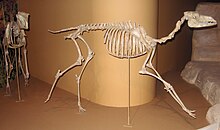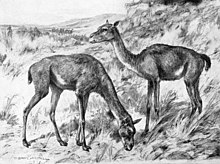| Stenomylus Temporal range: Oligocene - early Miocene | |
|---|---|

| |
| Skeletons | |
| Scientific classification | |
| Domain: | Eukaryota |
| Kingdom: | Animalia |
| Phylum: | Chordata |
| Class: | Mammalia |
| Order: | Artiodactyla |
| Family: | Camelidae |
| Genus: | †Stenomylus Peterson 1907 |
| Type species | |
| †Stenomylus gracilis Peterson, 1907 | |
| Other species | |
Stenomylus is an extinct genus of miniature camelid native to North America that is known from the Oligocene and Miocene epochs. Its name is derived from the Greek στενός (stenós, "narrow") and μύλος (mýlos, "molar").
Stenomylus was extremely diminutive compared to other ancient and modern camelids, standing only 2 feet (61 cm) tall on average. It was a slender animal with a long neck, having some resemblance to a modern gazelle. Based on theories about its biomechanics, unlike modern camelids, Stenomylus lacked padding on its hooves.
Description

Despite being a camelid, the gracile Stenomylus looked very similar to today's gazelles. The legs, were extremely elongated and bore only two toes; the legs had separate metacarpal but some species showed an incipient fusing of metacarpals, especially in the metatarsus. The nail phalanges suggest the presence of hooves similar to those of deer, and not of fleshy pads like those of today's camels.

The neck of Stenomylus was greatly elongated, making it vaguely similar to the modern gerenuk. The head was small, rounded and with a short muzzle. The nasal bones, set quite far back in the skull, suggest the presence of a small proboscis or at least of muscular prehensile lips. This characteristic is even more accentuated in the related (and slightly later) Rakomylus. The dentition of Stenomylus was very specialized: the anterior teeth were small, and the third incisor, as well as the first premolar, were similar to the canine. The upper second and third premolars were very small, and there was a diastema between the first and second premolars. Both the upper and lower molars were hypsodont in structure, and possessed deep roots even in mature individuals.
Classification


The genus Stenomylus was first described by Peterson in 1907, on the basis of fossil remains found in lower Miocene soils of Nebraska. The type species is Stenomylus gracilis. Another well-known species is Stenomylus hitchcocki, known from numerous specimens found in the Agate Springs area in Nebraska, in a quarry later known as "Stenomylus Quarry". Stenomylus is a very specialized genus of camelids, classified in a separate subfamily, the Stenomylinae, which likely originated at the end of the Oligocene. The specialization in the lengthening of the legs and the retraction of the nasal bones, as well as in the teeth, are accentuated even more in later forms such as Rakomylus.
References
- ^ Loomis, FB; 1910 "Osteology and affinities of the genus Stenomylus". American Journal of Science 179: 297-323
- στενός. Liddell, Henry George; Scott, Robert; A Greek–English Lexicon at the Perseus Project
- μύλος. Liddell, Henry George; Scott, Robert; A Greek–English Lexicon at the Perseus Project
- Palmer, D., ed. (1999). The Marshall Illustrated Encyclopedia of Dinosaurs and Prehistoric Animals. London: Marshall Editions. p. 277. ISBN 1-84028-152-9.
- ^ Peterson, OA; 1907 "The Miocene Beds of Western Nebraska and Eastern Wyoming and Their Vertebrate Faunae." Annals of Carnegie Museum. 4 (3): 21–72.
- C. Frick and BE Taylor. 1968. A Generic Review of the Stenomyline Camels. American Museum Novitates 2353: 1-51
External links
- Stenomylus image and description from the USGS
| Taxon identifiers | |
|---|---|
| Stenomylus | |
 | This prehistoric even-toed ungulate-related article is a stub. You can help Misplaced Pages by expanding it. |